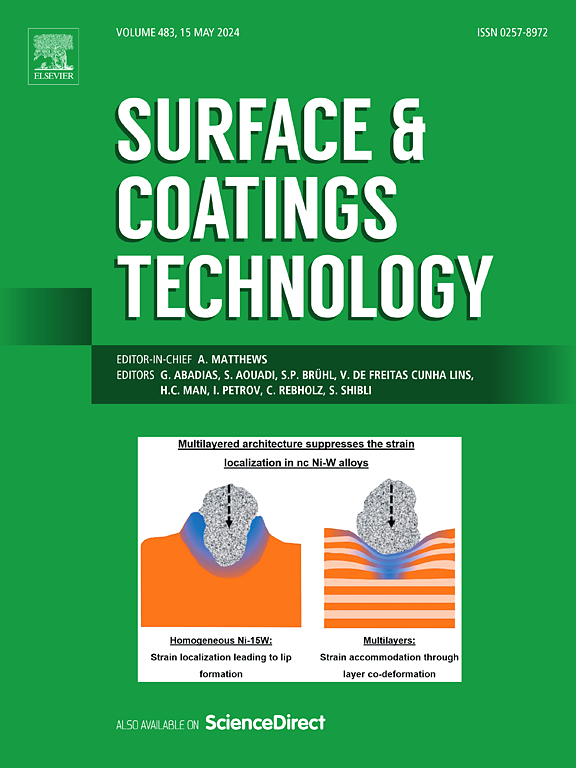Sustainable corrosion protection of aluminium alloys using a bio-based carbohydrate inhibitor
IF 5.3
2区 材料科学
Q1 MATERIALS SCIENCE, COATINGS & FILMS
引用次数: 0
Abstract
AA 6061 aluminium alloy is valued for its high strength-to-weight ratio and corrosion resistance but remains vulnerable to localized attack in chloride-rich environments. This drives the demand for eco-friendly, non-toxic corrosion inhibitors. The synthesis of hexamethylene-1,6-bis(N-D-glucopyranosylamine) (HGA) was successfully accomplished, and its potential as a corrosion inhibitor for AA 6061 aluminium alloy was investigated in a 3.5 % NaCl environment. Initial evaluation involved immersion tests of the alloy in inhibitor-containing saline media. Comprehensive electrochemical characterization was performed using electrochemical impedance spectroscopy (EIS) and potentiodynamic polarization techniques to assess the corrosion inhibition performance of HGA. To elucidate the interaction of HGA with the alloy surface, Attenuated Total Reflectance Infrared (ATR-IR) spectroscopy was employed, confirming the presence of functional groups in the protective inhibitor layer. Surface morphology analysis via Field Emission Scanning Electron Microscopy (FE-SEM) revealed a uniform protective film formation, while Energy Dispersive X-ray Spectroscopy (EDX) verified the elemental composition of the inhibitor and corrosion products. A significant reduction in corrosion current density, along with an enhanced polarization resistance of 75,730 Ω·cm2, demonstrated the superior corrosion resistance conferred by the HGA film compared to the untreated alloy. Notably, the HGA-coated surface maintained its impedance stability even after 168 h of continuous immersion in 3.5 % NaCl solution, indicating durable and sustained protection. These findings underscore the promise of HGA as a novel, eco-friendly corrosion inhibitor for aluminium alloys in aggressive chloride environments.
生物基碳水化合物缓蚀剂对铝合金的可持续腐蚀保护
AA 6061铝合金因其高强度重量比和耐腐蚀性而受到重视,但在富含氯化物的环境中仍然容易受到局部侵蚀。这推动了对环保、无毒腐蚀抑制剂的需求。成功合成了六亚甲基-1,6-二(n - d -葡萄糖氨基乙胺)(HGA),并在3.5% NaCl环境下研究了其作为AA 6061铝合金缓蚀剂的潜力。最初的评估包括合金在含抑制剂的盐水介质中的浸泡试验。利用电化学阻抗谱(EIS)和动电位极化技术对HGA的缓蚀性能进行了全面的电化学表征。为了阐明HGA与合金表面的相互作用,采用了衰减全反射红外(ATR-IR)光谱,证实了保护抑制剂层中存在官能团。通过场发射扫描电镜(FE-SEM)对表面形貌进行分析,发现形成了均匀的保护膜,而能量色散x射线光谱(EDX)验证了缓蚀剂和腐蚀产物的元素组成。腐蚀电流密度显著降低,极化电阻提高至75,730 Ω·cm2,表明HGA膜与未经处理的合金相比具有优越的耐腐蚀性。值得注意的是,即使在3.5% NaCl溶液中连续浸泡168 h后,hga涂层表面仍保持其阻抗稳定性,表明其具有持久的保护作用。这些发现强调了HGA作为一种新型的、环保的铝合金在侵略性氯化物环境中的缓蚀剂的前景。
本文章由计算机程序翻译,如有差异,请以英文原文为准。
求助全文
约1分钟内获得全文
求助全文
来源期刊

Surface & Coatings Technology
工程技术-材料科学:膜
CiteScore
10.00
自引率
11.10%
发文量
921
审稿时长
19 days
期刊介绍:
Surface and Coatings Technology is an international archival journal publishing scientific papers on significant developments in surface and interface engineering to modify and improve the surface properties of materials for protection in demanding contact conditions or aggressive environments, or for enhanced functional performance. Contributions range from original scientific articles concerned with fundamental and applied aspects of research or direct applications of metallic, inorganic, organic and composite coatings, to invited reviews of current technology in specific areas. Papers submitted to this journal are expected to be in line with the following aspects in processes, and properties/performance:
A. Processes: Physical and chemical vapour deposition techniques, thermal and plasma spraying, surface modification by directed energy techniques such as ion, electron and laser beams, thermo-chemical treatment, wet chemical and electrochemical processes such as plating, sol-gel coating, anodization, plasma electrolytic oxidation, etc., but excluding painting.
B. Properties/performance: friction performance, wear resistance (e.g., abrasion, erosion, fretting, etc), corrosion and oxidation resistance, thermal protection, diffusion resistance, hydrophilicity/hydrophobicity, and properties relevant to smart materials behaviour and enhanced multifunctional performance for environmental, energy and medical applications, but excluding device aspects.
 求助内容:
求助内容: 应助结果提醒方式:
应助结果提醒方式:


